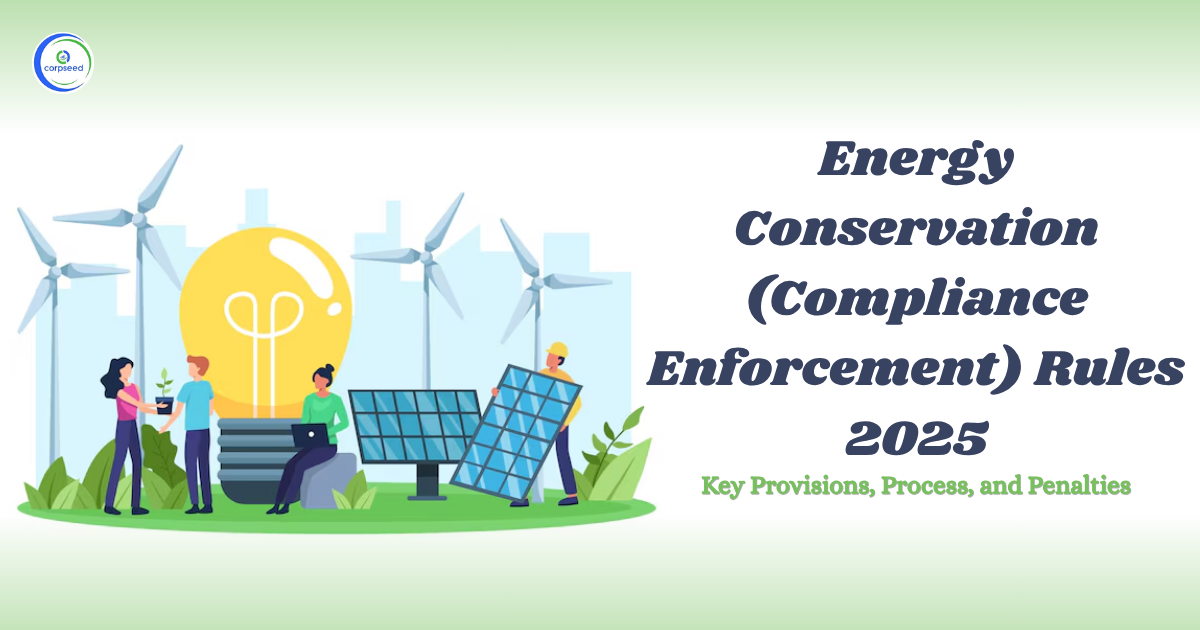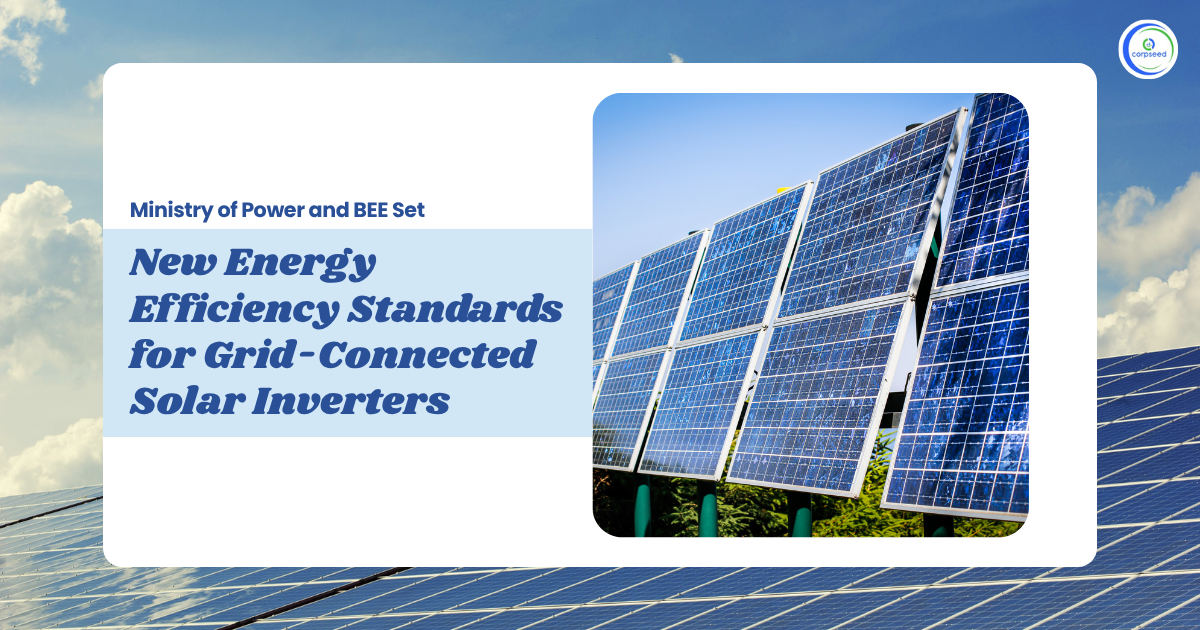The nation places high importance on using energy in a smart, efficient, and sustainable way. To support that aim, the Energy Conservation Act of 2001 was enacted. The Bureau of Energy Efficiency (BEE) and the Ministry of Power have now issued the Energy Conservation (Compliance Enforcement) Rules, 2025. These rules set out what happens when organisations or manufacturers fail to comply with the required energy norms. The rules help make energy conservation not just a goal, but a practical, enforceable action.
Table of Contents
- What Are Energy Conservation (Compliance Enforcement) Rules?
- Key Features of the Energy Conservation Rules
- Importance of the Energy Conservation Rules
- Process of Energy Compliance
- Penalties Credited into the Central Energy Conservation Fund
- Responsibility of BEE (Bureau of Energy Efficiency)
- Impact of Energy Rules on Stakeholders
- Conclusion
--------------Blog Contact Form-------------
What Are Energy Conservation (Compliance Enforcement) Rules?
These rules are regulatory provisions made under the Energy Conservation Act of 2001. They detail how compliance, verification, and enforcement should work when certain entities fail to meet energy-efficiency or conservation norms. The rules:
- Apply to entities such as manufacturers/importers, designated consumers, and other persons covered under specific sections of the Act.
- Empower BEE to obtain information, verify compliance, serve notices, and represent non-compliance matters before adjudicating officers.
- Provide for penalties for failure to comply, as provided under the Act (Section 26), and set out how such penalties will be credited into the fund called the Central Energy Conservation Fund.
Key Features of the Energy Conservation Rules
Here are the main aspects of the rules:
1. Applicability: The rules apply to:
- persons covered under Section 13A of the Act (e.g., large consumers, buildings, etc.)
- manufacturers or importers as per Clause (c) of Section 14 of the Act
- designated consumers under Clauses (n) and (x) of Section 14 of the
2. Norms and Standards: BEE is made responsible for enforcing the norms and standards specified by the central government. In case of shortfall (i.e., where targets or standards are not met), the central norms apply (and state norms do not cumulatively apply).
3. Reporting: Entities must furnish necessary information to BEE regarding compliance under the Act.
4. Verification: BEE (or designated agencies) will verify compliance and submit a report to the central government.
5. Jurisdiction of State Commission / Adjudicating Officer: The officer appointed by the relevant state regulator handles the adjudication. Where the office of the manufacturer/importer is located, or where the industry/establishment is located.
Importance of the Energy Conservation Rules
These rules carry significance in many ways:
- They turn energy‐efficiency norms from voluntary or advisory to legally enforceable. That means manufacturers and large consumers cannot simply neglect energy norms without consequence.
- They provide clarity about who is responsible, what standards apply, and where legal jurisdiction lies. That helps reduce confusion and strengthens implementation.
- They promote more efficient energy use, leading to cost savings, environmental benefits (reduced consumption and lower emissions), and supporting national goals related to sustainability and climate change.
- They help make industry and large consumers more accountable, ensuring that energy use is optimised and waste is reduced.
- They ensure that penalty funds (when collected) are channelled into a dedicated energy-conservation fund (the CECF), which can support further energy-saving initiatives.
Process of Energy Compliance
The compliance process under these rules may be described in steps:
- The Bureau of Energy Efficiency (BEE) or its designated agencies verify that entities comply with the Energy Conservation (Compliance Enforcement) Rules 2025.
- If any entity fails to comply, the Bureau sends a notice to that entity.
- The Bureau or agency then appoints representatives to present the case before the adjudicating officer.
- This process ensures fair action, better energy compliance, and promotes strong energy efficiency in India.
Penalties Credited into the Central Energy Conservation Fund
An important feature of the rules is how penalties are handled:
- All penalties collected under the Energy Conservation (Compliance Enforcement) Rules, 2025, go into the Central Energy Conservation Fund (CECF).
- From this fund, 90% of the penalty amount is remitted to the State Government, and 10% is remitted to the Central Government.
- For appliances, equipment, and vehicles, the State's share depends on the manufacturer's or importer's total sales during the compliance period.
- For industries listed as designated consumers, the penalty amount is sent to the State where the industry or unit is located.
- For non-fossil energy consumption, the money goes to the State where the industry or its head office operates.
- Any other amount recovered for compliance, not falling under penalties, is also credited to the Central Energy Conservation Fund.
Responsibility of BEE (Bureau of Energy Efficiency)
The Bureau has a central role in making the rules practical:
- BEE is responsible for enforcing the norms and standards specified by the central government and ensuring compliance by the concerned entities.
- BEE must obtain the necessary information from entities, verify compliance, and submit reports to the Central Government.
- BEE (or through its designated agencies) serves notices for non-compliance and may authorise its representatives to appear before adjudicating officers to represent non-compliance cases.
- BEE must take all actions required to implement the rules.
- The role involves coordination with State Electricity Regulatory Commissions, adjudicating officers, and ensuring that the statutory process is followed, so that compliance becomes more robust and transparent.
Impact of Energy Rules on Stakeholders
The impact of these rules spans across various stakeholders:
- Manufacturers/importers of appliances, equipment, vehicles: Must comply with energy standards, face penalties if there is a shortfall.
- Designated consumers (large industries, establishments with high energy use): Must meet targets for energy efficiency, non-fossil consumption as specified. Shortfall triggers the Rules' procedures.
- States and the Centre: The State Commissions will have jurisdiction for adjudication. Funds collected will partly go to the States to support further energy conservation work.
- BEE and compliance agencies: Greater role in oversight, issuance of notices, and representation before adjudicators.
Conclusion
The Energy Conservation (Compliance Enforcement) Rules 2025 establish a strict framework for energy conservation and efficiency across India. These rules make every manufacturer, importer, and industry follow clear energy efficiency norms. The Bureau of Energy Efficiency (BEE) plays a key role in checking compliance and taking action against violations. The collected penalties support the Central Energy Conservation Fund, which helps future conservation projects. This framework builds a cleaner, energy-smart India and strengthens the country's commitment to sustainable development and green growth.
This portion of the site is for informational purposes only. The content is not legal advice. The statements and opinions are the expression of author, not corpseed, and have not been evaluated by corpseed for accuracy, completeness, or changes in the law.
BOOK A FREE CONSULTATION
Get help from an experienced legal adviser. Schedule your consultation at a time that works for you and it's absolutely FREE.




.webp)




